Anniversaries 23 April | ||
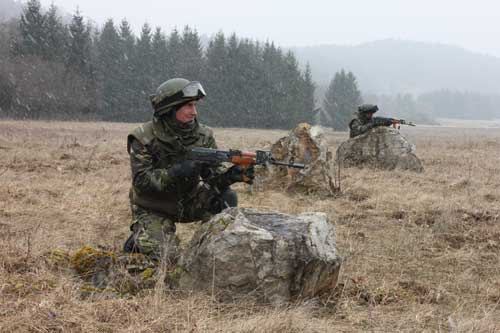 | ||
Founded 24 November [O.S. 12 November] 1859 Commander-in-Chief of the Land Forces Staff Lieutenant General SCARLAT DUMITRU Similar Romanian Armed Forces, Romanian Naval Forces, Romanian Air Force, United States Army Eur, Bulgarian Land Forces Profiles | ||
Romanian land forces mpeg
The Romanian Land Forces (Romanian: Forțele Terestre Române) is the army of Romania, and the main component of the Romanian Armed Forces. In recent years, full professionalisation and a major equipment overhaul have transformed the nature of the force.
Contents
- Romanian land forces mpeg
- Mission
- History
- Romanian War of Independence
- Second Balkan War
- World War I
- Hungarian Romanian War of 1919
- World War II
- Cold War
- Post communist era
- Manpower
- Modernisation
- Structure
- Equipment
- Special Forces
- International missions
- Training
- Ranks and insignia
- References
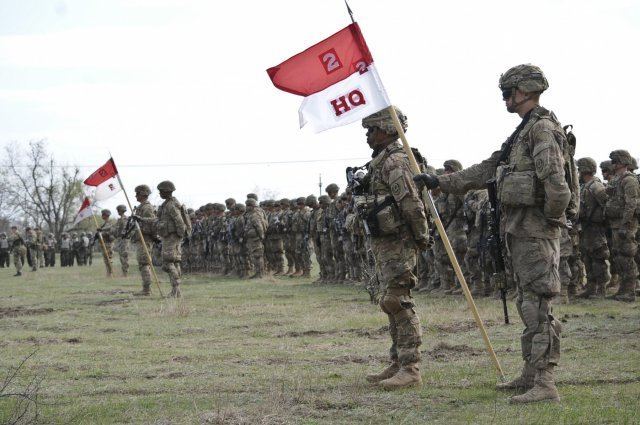
The Romanian Land Forces were founded on 24 November [O.S. 12 November] 1859. They participated in World War I, together with the Russian Empire forces in actions against the Central Powers and, despite initial setbacks, won the decisive battles of Mărăşti and Mărăşeşti. During most of World War II (until August 23, 1944) Romanian forces supported the Axis powers, fighting against the Soviet Union on the Eastern Front. From August 1944 until the end of the war, Romania fought against Germany under the control of the Soviet Union. When the communists seized power after the Second World War, the army underwent reorganisation and sovietization.

Following the Romanian Revolution, due to shortage of funds, many units were disbanded and much equipment was phased out. Likewise, Romanian military capability declined because of a lack of fuel as well as training. However, since the late 1990s, a number of positive changes have come about and the level of combat readiness is growing greatly; since 1996, the military budget has grown more than four times - rising from 636 million dollars to 2.8 billion dollars in 2007. Conscription has been abolished and professionalisation has been completed.

Mission
History
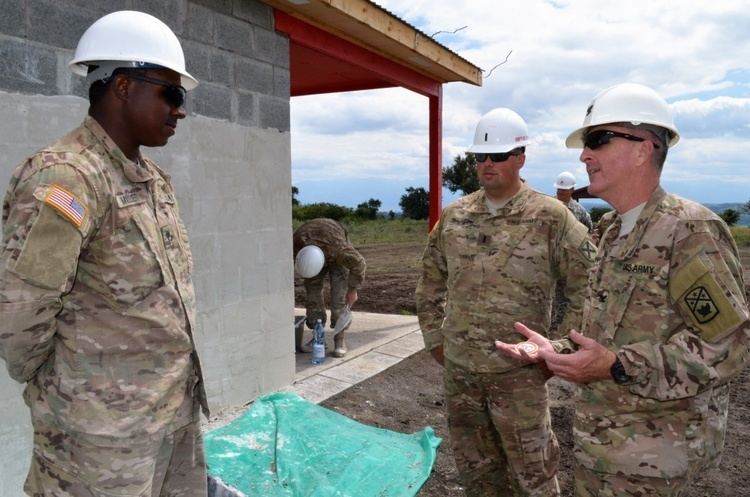
The first attempt to create an independent Romanian army was made by Gheorghe Magheru during the 1848 Wallachian Revolution, and it was based at Râureni (now part of Râmnicu Vâlcea). However, Magheru rapidly ordered his troops to disband when the Ottoman forces swept into Bucharest to stop the revolution.
Romanian War of Independence
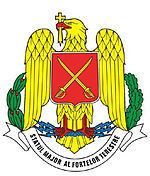
The current Romanian Land Forces were formed in 1859, immediately after the unification of Wallachia with Moldavia, and were commanded by Alexandru Ioan Cuza, Domnitor of Romania until his abdication in 1866. In 1877, at the request of Nikolai Konstantinovich, Grand Duke of Russia the Romanian army fused with the Russian forces, and led by King Carol I, fought in what was to become the Romanian War of Independence. They participated in the Siege of Plevna and several other battles. The Romanians won the war, but suffered about 27,000 casualties. Until World War I, the Romanian army didn't face any other serious actions.
Second Balkan War
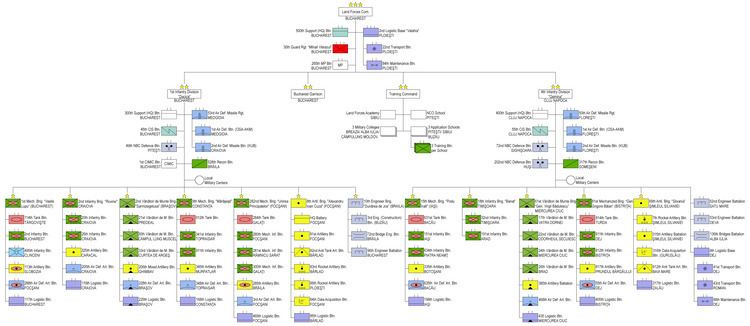
The Romanian Army entered the Second Balkan War against Bulgaria, allowing Romania to annex Southern Dobruja (also known as the Cadrilater). Although some 330,000 troops were mobilised, the Romanians met little resistance in Bulgaria and as such this is not considered a major conflict in Romanian history. This was due to historical claims on land. This area no longer belongs to Romania.
World War I
On July 6, 1916, Romania declared war on Germany and Austria-Hungary, following the initial success of the Brusilov Offensive (a major Russian offensive against the armies of the Central Powers on the Eastern Front). The Romanian armies entered Transylvania (then part of the Austro-Hungarian Empire), together with Russian forces. However, German forces under the command of General Erich von Falkenhayn stalled the attack in November, 1916, and drove back the Romanians. At the same time, Austrian and Turkish troops invaded southern Romania, forcing the country into a two-front war. The Central Powers drove deep into Romania and conquered the south of the country (Wallachia, including Bucharest) by the end of 1916. The Romanian forces, led by Marshal Constantin Prezan, retreated into the north-east part of Romania (Moldavia). In the summer of 1917 however, Prezan, aided by the future Marshal, General Ion Antonescu, successfully defended the remaining unoccupied territories against German and Austro-Hungarian forces led by Field Marshal August von Mackensen. General Alexandru Averescu led the Second Army in the victories of the Battle of Mărăşti (July 22 to August 1, 1917) and the Battle of Mărăşeşti (August 6 to September 8, 1917). As a result of the Russian Revolution, Romania was left isolated and unable to continue the war, and was forced to sign the Treaty of Bucharest with the Central Powers. Later on, in 1919, Germany agreed, in the Treaty of Versailles Article 259, to renounce all the benefits provided to it by the Treaty of Bucharest in 1918. After the successful offensive on the Thessaloniki front, which put Bulgaria out of the war, Romania re-entered the war on November 10, 1918, a day before its end in the West.
Hungarian-Romanian War of 1919
After World War I, Transylvania proclaimed union with the Kingdom of Romania. As a result, in April 1919, the newly established Hungarian Soviet Republic vowed to retake the region by force, and Hungarian troops attacked Romanian formations in Transylvania. The Romanian Army defeated the Hungarians and conquered Budapest in August 1919.
From 1921 to 1939 in Transylvania Inspectorate General of Army no. 3 had subordinate the 6th and 7th Army Corps. By 1 April 1921, when he disbanded Forces Western Command, to order 6th Army Corps (and earlier structures) have been generals Prezan Constantin, Constantin Christescu Traian Mosoiu, Mardarescu George, Nicholas and Arthur Văitoianu et al. After 1 April 1921 to 23 March 1939, C. 6 A. was commissioned by General Nicholas Petal, Danila Pop Hanzu Alexander, John Prodan, Motas Dumitru Gheorghe Florescu and Christie Doe, prominent military leaders, whom Octavian Goga wrote that "in the interwar period, in Cluj in Transylvania, commanders have made a large-scale opera and unanimous praise. " Three divisions were part of 6th Army Corps: 16th (Dej), 17th (Oradea) and 20th Infantry Divisions (Targu-Mureş). With rapid and marked worsening international situation, especially in neighboring Romania, on 22 September 1939, the 4th Army, recently founded, became Army Group Command no. 1 of Transylvania.
World War II
After General (later Marshal) Ion Antonescu took power in September 1940, Romania signed the Tripartite Pact with the Axis Powers and subsequently took part in Operation Barbarossa in 1941. An expeditionary force invaded the Soviet Union in Bessarabia and southern Ukraine, alongside the German Wehrmacht. The expeditionary force, 'Army Group Antonescu,' was composed on 22 June 1941 of the 3rd Army, the 4th Army, the 2nd Army Corps, and the 11th Infantry Division. The 3rd Army comprised the 4th Army Corps (6th and 7th Infantry Divisions), the Cavalry Corps, the Mountain Corps, two separate artillery battalion, a TA unit, and the Air Force's 3rd Army Cooperation Command. The 4th Army consisted of the 3rd Army Corps, the 5th Army Corps, the 11th Army Corps (two fortress brigades), and the 4th Army Cooperation Command. The army group-level 2nd Army Corps, under Major General N. Macici, controlled the 9th and 10th Infantry Divisions and the 7th Cavalry Brigade. Additionally the 1st Armoured Division was formed for service on the Eastern Front. The Army Group's first offensive, in conjunction with the Eleventh Army, Operation Munchen, enabled Romania to retake the territory immediately east of the Dnister, former part of Moldavia. The Romanian Armies saw their first major battles at Odessa and Sevastopol, and in 1942 advanced with other Axis forces deeper into Soviet territory during Operation Blue.
The greatest disaster for the Romanian expeditionary force on the Eastern Front came at Stalingrad, where, during the Soviet counter-offensive of November 1942, the thinly spread forces of the Third Army (deployed north of Stalingrad) and of the Fourth Army (deployed south of Stalingrad) were attacked by vastly superior Soviet forces and suffered combined losses of some 158,000 personnel.
During April–May 1944 the Romanian forces led by General Mihai Racoviţǎ, together with elements of the German Eighth Army were responsible for defending Northern Romania during the Soviet First Jassy-Kishinev Offensive, and took part in the Battles of Târgu Frumos. In late August 1944, the Red Army entered eastern Romania. On August 23, 1944, a coup led by King Michael I of Romania deposed Marshal Antonescu and set up a pro-Soviet government. It has been estimated that the royal coup shortened the war by six months. Romania soon declared war on Nazi Germany, and the First and Fourth Armies were pressed into action. After the expelling of the last Wehrmacht remnants from Romania, the Romanian Armies took part in the Siege of Budapest and the Prague Offensive of May 1945.
Cold War
The Soviet occupation of Romania led to a complete reorganisation of the Romanian Land Forces under the supervision of the Red Army. At the onset, pro-German elements were purged from the Romanian armed forces. In 1944–45, two divisions were formed out of Romanian volunteers—ex-prisoners of war, trained and indoctrinated in the Soviet Union during the war, but also of many Communist activists. One was the Tudor Vladimirescu First Volunteer Division, under the command of Colonel Nicolae Cambrea, and the other the Horia, Cloşca şi Crişan Division, under the command of General Mihail Lascăr (who later served as Minister of Defence from 1946 to 1947). These two units formed the nucleus of the new Romanian Land Forces under Soviet control. The postwar reorganisation of the Land Forces included cavalry but the arm disappeared from the force with the disbandment in November 1954 of the 59th Cavalry Division at Oradea.
After the Romanian Communist Party seized political power, the sovietization of the army commenced, under the supervision of the new Minister of Defence, Emil Bodnăraş. Thirty per cent of the officers and noncommissioned officers (mostly experienced soldiers, and a potential source of opposition) were purged from the military. This involved copying the Soviet model of military and political organisation, and changing the military doctrine of combat and defence, also in the context of Romania's integration in the strategic system of the Soviets, at the beginning of the Cold War.
In the early 1950s the RLF reached a level of 12 rifle, one mechanised, and one tank division. Between 1960 and 1964 the rifle and mechanised divisions were converted to motor rifle divisions, and reductions in strength began; force size dropped to six motor rifle and two tank divisions by 1970. From 1970 to 1976, three more motor rifle divisions were formed, but one was deactivated in 1977, and the eight motor rifle and three tank division figure remained that way for the rest of the Cold War.
From 1947 to 1960 the country seems to have been divided into three major military regions: Cluj, Bacău, and Bucharest in the west, east, and south, respectively. In wartime the land forces in each military region would become an army corps with their headquarters in Cluj-Napoca, Iaşi, and Bucharest. Armies seem to have succeeded military regions in 1960, and three armies seem to have become four in 1980. What is known is that on 01.07.1947 Fourth Army became 3rd Military Region, based in Cluj. The 3rd Military Region became the 3rd Army on 30 April 1960, and the 4th Army on 5 April 1980.
During the 1980s, the land forces numbered 140,000 personnel, of whom two thirds were conscripts. In 1989 four armies appeared to exist: the First Army at Bucharest, Second Army at Buzau, Third Army at Craiova, and Fourth Army at Napoca. In 1989 the land forces consisted of eight mechanised (infantry) divisions (1st, Bucharest, 2nd, Craiova, 9th, Constanta, 10th, Iași, 11th, Oradea, 18th, Timişoara, 67th, and 81st, Tirgu Mureş) two tank divisions (the 57th Tank Division at Bucharest and the 6th Tank Division at Tirgu Mureş), four mountain infantry brigades, and three airborne brigades. According to the 165-year 'History of Modern Romanian Artillery,' in 1989 the 1st Army consisted of the 1st Mech Div, 57th Tank Div., and the 2nd Mountain Brigade; the 2nd Army of the 9th Mech Div, 10th Mech Div, 67th Mech Div, and 32nd TActical Rocket Bde; the 3rd Army of the 2nd Mech Div, 18th Mech Div, and the 4th Mountain Bde; and the 4th Army of the 11th Mech Div, 81st Mech Div, 6th Tank Div., 1st Mountain Bde, 5th Mountain Bde, and 37th Tactical Missile Brigade.
Motorised rifle divisions were organized along the Soviet model with three motorised rifle regiments, one tank regiment, and a full complement of 12,000 infantry soldiers. The artillery, antitank, and air defence regiments of divisions provided specialised fire support that enabled motorised rifle and tank regiments to maneuver. The air defense regiments consisted of two anti-aircraft artillery battalions and one surface-to-air missile (SAM) battalion, each composed of several batteries. In the late 1980s the artillery regiments of motorised rifle and tank divisions included two artillery battalions, one multiple rocket launcher battalion, and one surface-to-surface missile battalion.
Surface-to-surface missile battalions were divided into three or four batteries, each equipped with one missile launcher. They operated thirty FROG-3 and eighteen SCUD missile launchers. The FROG-3, a tactical missile first introduced in 1960, was being replaced in other non-Soviet Warsaw Pact armies. Proven to be fairly inaccurate in combat, FROG and SCUD missiles would be ineffective weapons carrying conventional high-explosive warheads. Tipped with nuclear or chemical warheads, however, they could be devastating. According to one former Romanian official writing in 1988, Romania produced chemical agents that could be delivered by battlefield missiles.
Post-communist era
During the early 1990s, some major units were disbanded and a lot of equipment was phased out or scrapped due to a severe shortage of funds. The whole land forces structure was reorganized from armies into territorial corps, and from regiments into battalions. In the mid-1990s, the situation of the land forces was critical: the military budget was three times lower than in 1989 (636 million dollars), 50% of the equipment was older than 30 years, and 60% of the armoured vehicles and 85% of the missile units were non-operational. Due to lack of fuel and training, the level of combat readiness and military capability was extremely low (only about 30% of the entire land forces were operational). However, after 1996 the government took serious action; the military budget was increased greatly, and modernisation of equipment commenced. Officially, the program to modernize and restructure the armed forces began on 11 April 2000.
Manpower
In 2005, the army comprised eight combat, four combat support and two logistic brigades, while ten combat, five combat support and two logistic brigades could be further mobilised in case of crisis. Many of these units have been restructured, however, as part of the 2007 Force Plan.
Currently, about 75,000 military personnel and 15,000 civilians comprise the armed forces, for a total of 90,000 men and women. Out of these 75,000, cca. 43,000 are in the Land Forces.
Modernisation
The Romanian military is undergoing a three-stage restructuring. As of 2007, the first short-term stage was completed (reorganisation of the command system, implementation of the voluntary military service). The year 2015 marks the end of the second stage (operational integration in NATO and EU), while 2025 is the date when the long-term stage is to be completed (full technical integration in NATO and EU). The stages aim at modernising the structure of the armed forces, reducing the personnel as well as acquiring newer and improved technology that is compatible with NATO standards.
Romania abolished compulsory military service on October 23, 2006. This came about due to a 2003 constitutional amendment which allowed the parliament to make military service optional. The Romanian Parliament voted to abolish conscription in October 2005, with the vote formalising one of many military modernisation and reform programmes that Romania agreed to when it joined NATO in March 2004.
Structure
In peacetime, the commander of the land forces is the minister of defense, while in wartime, the President of Romania becomes the supreme commander of the armed forces. The main combat formations of Romania are the 2nd Infantry Division Getica, and the 4th Infantry Division Gemina. Until 2015 the Romanian land forces fielded a third division, namely the 1st Division Dacia. Before June 2008, the 1st and 4th divisions were known as the 1st Territorial Army Corps and the 4th Territorial Army Corps and in turn they used to be called the 1st Army and 4th Army prior to 2000. However due to their personnel having been reduced considerably in order to reach compatibility with NATO standards they were renamed and reorganized as divisions. In 2010, the Joint HQ command was renamed as 2nd Infantry Division Getica and received units from the 1st and the 4th Infantry divisions.
The current chief of the Romanian Land Forces Staff is Major General Nicolae Ciucă, who succeeded Major General Mircea Savu on 7 January 2014. The Land Forces official day is celebrated each year, on 23 April.
Equipment
The Romanian Land Forces have completely overhauled their equipment in the past few years, replacing it with a more modern one. The TR-85M1 "Bizon" main battle tank and the MLI-84M "Jder" infantry fighting vehicle are the most modern native made equipment of the Romanian Land Forces. Also, 43 ex-German Gepard anti-aircraft systems were commissioned in late-2004.
The Land Forces ordered about 100 US Army Humvees; the first eight were delivered to the military police in December 2006. 31 Piranha III armoured vehicles (LAV III variant) and 60 URO VAMTAC high mobility vehicles were also ordered in 2007 for deployment in Iraq and Afghanistan. The land forces are also purchasing additional Piranha III armored vehicles as well as planning on replacing its aging TAB armoured personnel carriers with a new vehicle that will be designed and produced in conjunction with the Germany company Rheinmetall.
Equipment Summary:
Special Forces
The evolution of the special forces within the Romanian Land Forces led to the establishment of the 1st Special Operations Regiment on 1 August 2009, headquartered at Târgu Mureş. It later became the 6th Special Operations Brigade on 25 October 2011, composed of a special operations battalion, two paratrooper battalions and a logistic battalion.
The most famous and well trained unit is the 1st Special Operations Battalion "Vulturii", which was legally created in late 2005, after several batches of graduates had already been selected. Members of the special forces battalion have benefitted from courses abroad, such as the US Army Special Forces (Green Berets) course, the United States Marine Corps Force Recon course, as well as other courses. The Special Forces battalion became fully operational during 2007, after a company had already been commissioned in early-2006.
The current Romanian reconnaissance battalions (the 313th, the 317th and the 528th) are also considered special forces units, and were formed in the 1960s during the communist regime. After the revolution, the units suffered from a lack of funds which resulted in the temporary disbandment of the 313th Battalion. However, their equipment was completely overhauled in the past few years and the combat readiness and capabilities have regained full strength.
DIR, Rapid Intervention Squad of the Romanian Ministry of Defense is an elite special operations unit currently belonging to the Romanian Military Police. It is a special unit inside the military, formed of highly skilled individuals, a very large percentage of its members being champions in martial arts, kickboxing, athletic disciplines and so on. DIR was, until December 2003, top secret.
International missions
The following troops are deployed abroad:
Training
After the Romanian Revolution, many firing ranges and training areas were closed and abandoned due to lack of funds. Currently, the military schools and training units of the Romanian Land Forces are directly subordinated to the central headquarters. There are 3 military high schools (Câmpulung Moldovenesc, Alba Iulia and Breaza), five military academies [1], one officers school (Piteşti), 3 training schools (Sibiu, Piteşti, Buzău) and 9 training battalions.
In the past few years, lots of training exercises took place in Romania with other Balkan or Allied countries. Most of these exercises took place at Babadag, which is one of the largest and most modern training firing ranges and military facilities in Europe, with a total surface area of 270 square kilometres. It was announced on December 6, 2006 that 1,500 U.S. troops stationed at Mihail Kogălniceanu, which in time will form Joint Task Force East, will be using Babadag as a training base.
Ranks and insignia
The Romanian Land Forces distinguishes four career paths: officers (Ofiţeri), warrant officers (Maiştrii militari), NCO's (Subofiţeri) and enlisted men (Soldaţi şi gradaţi voluntari). The Marshal rank can be given only in wartime by the President of Romania; in fact, Romania had only three marshals coming from the officers` rank in its history: Ion Antonescu, Alexandru Averescu and Constantin Prezan. Kings Ferdinand I, Carol II and Mihai I also held the rank of Marshal of Romania. King Carol I held simultaneous ranks as Russian Marshal and German Field-marshal.
